Earth's atmosphere

The atmosphere shows a surprising variety of characteristics on a vertical scale. Gravity means that air density and associated pressure increase near the surface. Pressure of about 1,000 millibars (mb) at sea-level falls to virtually nothing (10-42 mb) at a height of 720 kilometers (447 miles). Temperature also varies with height, falling and rising in several layers, ultimately increasing toward outer space. Even the mixture of gases shows variations, with water vapor being added at low levels. Four broad atmospheric layers can be identified. The exosphere (1) is a rarefied region above 400 kilometers (250 miles) with differing proportions of oxygen, helium, and hydrogen. The highest auroras are found in this region. The ionosphere (2), where charged particles (ions and electrons) occur is a deep layer comprising the mesosphere and thermosphere, subdivided into four minor layers (F2, F1, E, and D). Their ion density has a marked effect on radio waves – very high frequency waves penetrate but short-wave transmissions are reflected. The stratosphere (3) contains small but vital amounts of ozone filtering out harmful solar radiation. The troposphere (4) contains the bulk of the atmosphere and all its weather. Together with the outer layers it acts as particle and radiation shield. Temperatures decrease to its upper boundary.
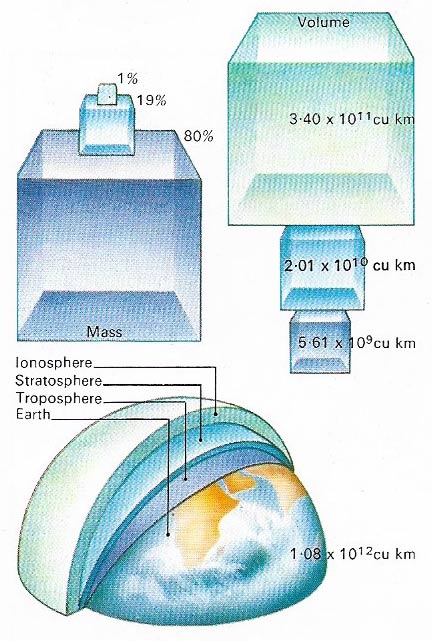
Figure 1. Air is easily compressed, so the atmosphere becomes :squashed" by the effect of gravity. This results in the bulk (80%) of the atmosphere being in the troposphere, occupying a volume of about 6 × 109 cu km. As air density decreases with altitude, the very much smaller amounts of air present in the stratosphere (19%) an the ionosphere and above (1%) occupy a greater and greater volume.
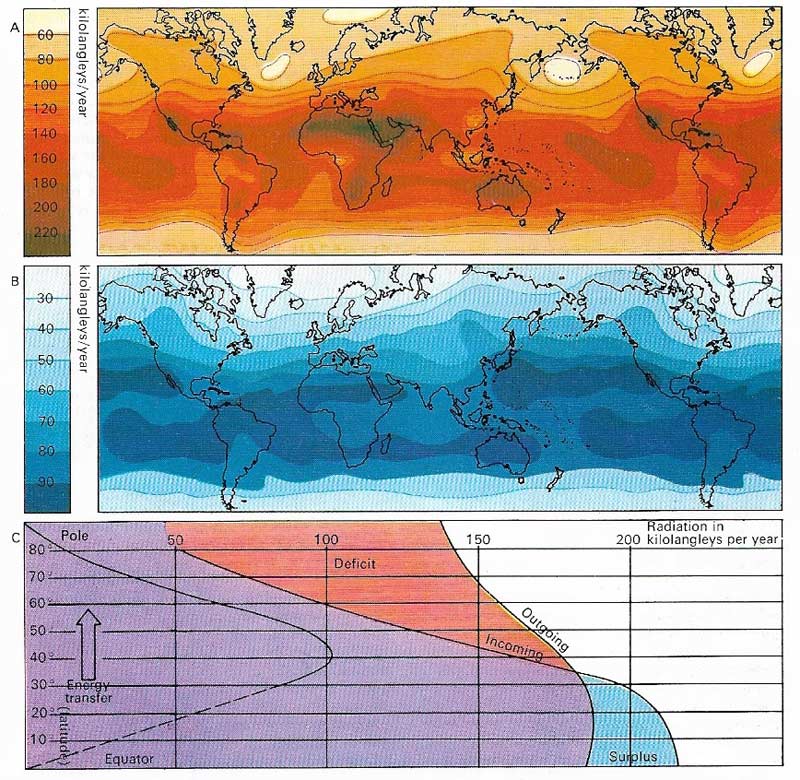
Figure 2. Temperatures in the atmosphere and on Earth result mainly from a balance of radiation inputs and outputs. Average annual solar radiation reaching the Earth, measured in kilolangleys (one calorie absorbed per sq cm) is highest in hot desert areas (A). Comparison with the average annual long-wave radiation back from the Earth's surface (B) shows an overall surplus radiation for nearly all latitudes but this is absorbed in the atmosphere and then lost in space, ensuring an overall balance. The extreme imbalance of incoming radiation between equatorial and polar latitudes is somewhat equalized through heat transfers by atmosphere and oceans (C). This balancing transfer between surplus and deficit radiation is greatest in middle latitudes where most cyclones and anticyclones occur, shown at a latitude of 40° on the chart.
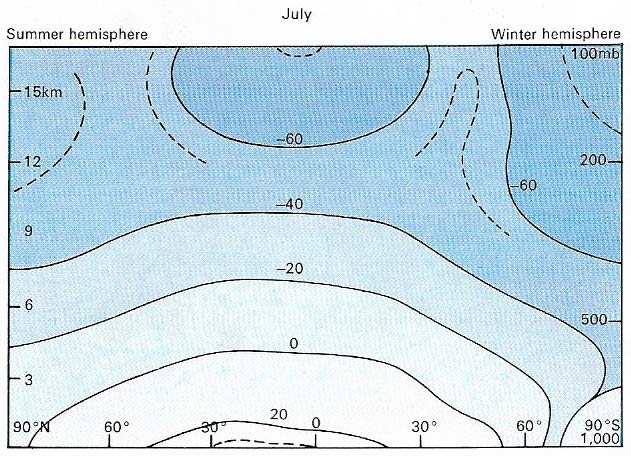
Fig 3. Atmospheric temperatures tend to decrease evenly with increase in height and latitude up to a level called the tropopause at a height of about 9 kilometers (5.5 miles) at the poles rising to 18 kilometers (11 miles) in the tropics.
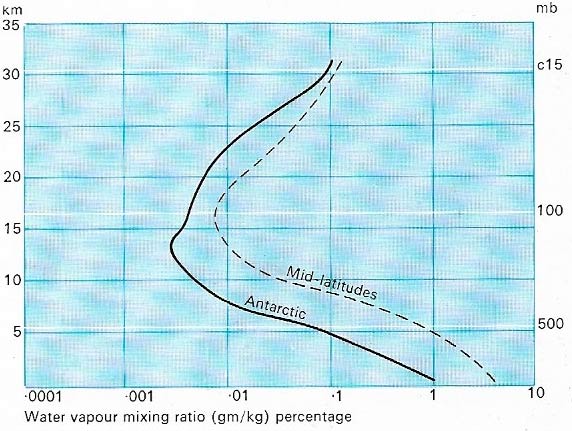
Figure 4. Humidity falls with height in the troposphere. Warm air can hold more water vapor than cold air and therefore the warmer mid-latitude atmosphere holds more water vapor than the colder air over the Antarctic region.
The composition of Earth's atmosphere at sea-level is approximately 78% nitrogen, 21% oxygen, 0.9% argon, and 0.04% carbon dioxide, with variable small amounts of water vapor and pollutants such as sulfur dioxide and carbon monoxide. Variations in temperature define the various layers of the atmosphere, which include, in ascending order, the troposphere, the stratosphere, the mesosphere, the thermosphere, and the exosphere.
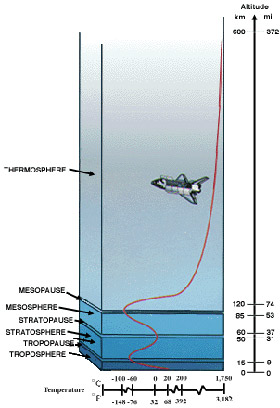 |
| The layers of Earth's atmosphere |
Regions of the atmosphere
Troposphere and stratosphere
The troposphere extends to a height of about 8 kilometers at the poles and 18 kilometers near the equator, and accounts for three-quarters of the atmospheric mass. At the top of the troposphere, where the temperature falls to –60°C, is the tropopause and, above this, the stratosphere. Temperatures within the stratosphere, where there is no vertical air movement, are at first steady and then rise to about 0°C at an altitude of about 50 kilometers. The heating within the stratosphere comes from the absorption of ultraviolet radiation from the Sun by molecules of ozone.
Above the stratosphere
Beyond the stratosphere is the mesosphere in which the temperature once again falls since ozone is less plentiful. At the top of the mesosphere, at a height of about 85 km, the temperature is –90°C. Above lies the thermosphere in which oxygen and nitrogen absorb solar ultraviolet causing the temperature to rise to about 1,300°C at a height of 500 kilometers. The heating effect of this high temperature, however, is negligible since the density at such altitudes is only one million millionth that at sea level. "Shooting stars" (trails of incinerating meteors) and aurorae are produced in this region. Finally, beyond the thermosphere, is the exosphere which contains the Van Allen radiation belts, extends into Earth's magnetosphere, and merges with the near-vacuum of interplanetary space.
Heated from below
Up to a height of about 50 kilometers (31 miles) the composition of the atmosphere is remarkably homogenous, comprising a mixture of gases each with their own physical properties. Carbon dioxide, water vapor, and ozone, although only small constituents of the atmosphere, play vital roles in absorption of solar and terrestrial radiation , thus allowing life on Earth. Due to the action of gravity, this homogenous mixture of gases is compressed (Figure 1) giving the highest values of density and pressure near Earth's surface; average surface density is 1.25 kilograms per cubic meter (kg/m3) and average surface pressure i s 1,013 millibars (mb) (roughly 1 kg/cm2 or 14 pounds per square inch). At a height of 16 kilometers (9 miles), pressure falls to 100 mb and the density is less than 11 percent of the density at sea-level.
The constituent gases of the atmosphere largely allow the Sun's radiation to pass without interception. Fortunately, the small amount of ozone, concentrated most strongly at 24 kilometers (15 miles) height, but in significant amounts up to 50 kilometers (31 miles), filters out most of the ultraviolet rays harmful to life on Earth. If all the ozone were brought down to sea-level, it would form a layer on 0.25 centimeter (0.1 inch) thick. After scattering, reflection, and some absorption in the lower, denser layers of the atmosphere, only about 46 percent of the solar radiation reaching the upper atmosphere is absorbed by the solid Earth's surface as heat. This input of energy raises Earth's surface to a mean temperature of 14°C (57°F). Because this is lower than the 5,700°C (10,290°F) of the Sun's surface, Earth radiates energy of much longer wavelengths (infrared or heat rays) than solar radiation and these longer waves are absorbed by the carbon dioxide, water vapor, and cloud in the lower atmosphere.
This means that the atmosphere is directly heated from below, not from above as one might expect. Just as Earth radiates heat, so does the atmosphere – upward to be lost to space and downward to be reabsorbed by Earth. The net effect of these exchanges (Figure 2) is that together they lose as much heat to space as they gain from solar radiation, thus maintaining a balance.
Temperature distribution
In the bottom 80 percent (in mass) of the atmosphere, temperature falls with height in accord with the heating from below (Figure 3). This layer of the atmosphere, 8 km (5 miles) deep in polar regions, and 16–19 kilometers (about 11 miles) deep over the equatorial regions, is known as the troposphere. It is characterized by wind speeds, increasing with height, lots of moisture at low levels, and appreciable vertical air movement, and it is generally the source of all the "weather" we experience. The tropopause marks the boundary between the troposphere and the stratosphere.
The temperature is virtually constant throughout the lower stratosphere but this layer has strong air circulation patterns and high wind speeds in the jet streams which are used (when they blow in the right direction) by airliners. In the upper stratosphere, above about 25 km (15 miles), temperature gradually increases with height to a broad maximum at the stratopause. Above the stratopause, in the mesosphere, the temperature begins to decline sharply with increasing height, to a minimum at about 85 km (52 miles). Above this level, which is called the mesopause, is the thermosphere where temperature is believed to increase to the thermopause at 400 kilometers (250 miles). Beyond, in the exosphere, the pressure drops to virtually a vacuum – equivalent to that of the Sun's outer atmosphere in which Earth orbits.
Within the troposphere another type of heat balance operates. More radiant heat is received than lost in tropical latitudes and the converse is true in polar latitudes. This broad temperature gradient from equator to pole generates a pressure gradient in the same direction; warm air moves down the gradient, reducing temperature extremes by cooling the tropics and warming the polar areas (Figure 2C).
Humidity of the atmosphere
The water content of the atmosphere is primarily in vapor form. Humidity decreases with height (Figure 4) because water enters the atmosphere by evaporation from Earth's surface. The driest parts of the lower atmosphere are over the subtropical deserts, the wettest are over the equatorial and summer monsoon regions, especially ocean surfaces. Water is constantly being cycled between Earth and the atmosphere. The amount in the atmosphere at any one time is only a fraction of one per cent of the total water in the planet, but it provides enough rainfall to sustain life on Earth.
Evolution of Earth's atmosphere
The earliest terrestrial atmosphere probably formed from the vaporization of volatile materials in the outer layers of Earth's crust and was gradually altered by a number of factors, including the later presence of life, until it acquired its present composition (see Earth, early history).
 |
| Earth's atmosphere seen from space |


